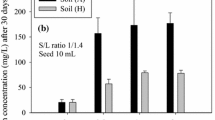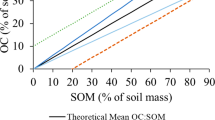Abstract
Soils contain various iron compounds that differ in solubility, reducibility and extractability. Moreover, the contribution of the various iron compounds to total iron (Fe) and total Fe concentrations differs highly among soils. As a result, the total reducible Fe content can also differ among soils, and so does the dynamics of iron reduction. These factors complicate the prediction of reducible Fe based on Fe extraction data and hamper the application of process-based models for reduced or waterlogged soils where redox processes play a key-role. This paper presents a theoretical analysis relating reducible to extractable Fe reported in the literature. Predictions made from this theoretical analysis were evaluated in soil incubations using 18 rice paddy soils from all over the world. The incubation studies and the literature study both show that reducible Fe can be related to Fe from some selected, but not all, iron extractions. The combination of measurements for labile Fe(III)oxides (derived from oxalate-extractable Fe) and stabile Fe(III)oxides (derived from dithionite-citrate-extractable Fe) shows highly significant correlations with reducible Fe with high coefficients of determination (r2 = 0.92−0.95 depending on the definition of stabile Fe(III)oxides). Given the high diversity in rice soils used for the incubations, these regression equations will have general applicability. Application of these regression equations in combination with soil database information may improve the predictive ability of process-based models where soil redox processes are important, such as CH4 emission models derived for rice paddies or wetlands.
Similar content being viewed by others
References
Amirbahman A., Schoenenberger R., Johnson C.A. and Sigg L. 1998. Aqueous-and solid-phase biogeochemistry of a calcareous aquifer system downgradient from a municipal solid waste landfill (Winterthur, Switzerland). Environ. Sci. Technol. 32: 1933–1940.
Batjes N.H. (ed.) 1995. A homogenized soil data file for global environmental research: a subset of FAO, ISRIC and NRCS profiles (version 1.0). Working paper 95/10. International Soil Reference and Information Centre (ISRIC), Wageningen, the Netherlands.
Canfield D.E. 1989. Reactive iron in marine sediments. Geochim. Cosmochim. Acta 53: 619–632.
Canfield D.E. and Thamdrup B. 1996. Fate of elemental sulfur in an intertidal sediment. FEMS Microbiol. Ecol. 19: 95–103.
Christensen T.H., Bjerg P.L., Banwart S.A., Jakobsen R., Heron G. and Albrechtsen H.-J. 2000. Characterization of redox conditions in groundwater contaminant plumes. J. Contam. Hydr. 45: 165–241.
Elsgaard L. and Jørgensen B.B. 1992. Anoxic transformations of radiolabeled hydrogen sulfide in marine and freshwater sediments. Geochim. Cosmochim. Acta 56: 2425–2435.
Gotoh S. and Patrick W.H. Jr 1974. Transformations of iron in waterlogged soils as influenced by redox potential and pH. Soil Sci. Soc. Am. Proc. 38: 66–71.
Heron G., Crouzet C., Bourg A.C.M. and Christensen T.H. 1994. Speciation of Fe(II) and Fe(III) in contaminated aquifer sediments using chemical extraction techniques. Environ. Sci. Technol. 28: 1698–1705.
Holzapfel-Pschorn A., Conrad R. and Seiler W. 1986. Effects of vegetation on the emission of methane from submerged paddy soil. Plant Soil 92: 223–233.
Inubushi K., Wada H. and Takai Y. 1984. Easily decomposable organic matter in paddy soil. Soil Sci. Plant Nutr. 30: 189–198.
Jakobsen R. and Postma D. 1999. Redox zoning, rates of sulfate reduction and interactions with Fereduction and methanogenesis in a shallow sandy aquifer. Romo, Denmark. Geochim. Cosmochim. Acta 63: 137–151.
Jugsujinda A. and Patrick W.H. Jr 1996. Methane and water soluble iron production under controlled soil pH and redox conditions. Comm. Soil Sci. Plant Anal. 27: 2221–2227.
Klüber H.D. and Conrad R. 1998. Effects of nitrate, nitrite, NO and N2O on methanogenesis and other redox processes in anoxic rice field soil. FEMS Microbiol. Ecol. 25: 301–318.
Leventhal J. and Taylor C. 1990. Comparison of methods to determine degree of pyritization Geochim. Cosmochim. Acta 54: 2621–2625.
Lovley D.R. 1991. Dissimilatory Fe(III) and Mn(IV) reduction. Microbiol. Rev. 55: 259–287.
Lovley D.R. and Phillips E.J.P. 1986. Organic matter mineralization with reduction of ferric iron in anaerobic sediments. Appl. Environ. Microbiol. 51: 683–689.
Lovley D.R. and Phillips E.J.P. 1988. Novel mode of microbial energy metabolism: organic carbon oxidation coupled to dissimilatory reduction of iron or manganese. Appl. Environ. Microbiol. 54: 1472–1480.
Luther G.W. III, Giblin A., Howarth R.W. and Ryans R.A. 1982. Pyrite and oxidized mineral phases formed from pyrite oxidation in salt marsh and estuarine sediments. Geochim. Cosmochim. Acta 46: 2665–2669.
McKeague J.A. and Day J.H. 1966. Dithionite-and oxalate-extractable Fe and Al as aids in differentiating various classes of soils. Can. J. Soil Sci. 46: 13–22.
McKeague J.A., Brydon J.E. and Miles N.M. 1971. Differentiation of forms of extractable iron and aluminium in soils. Soil Sci. Soc. Am. Proc. 35: 33–38.
Raiswell R., Canfield D.E. and Berner R.A. 1994. A comparison of iron extraction methods for the determination of degree of pyritisation and the recognition of iron-limited pyrite formation. Chem. Geol. 111: 101–110.
Ratering S. and Schnell S. 2000. Localization of iron-reducing activity in paddy soil by profile studies. Biogeochemistry 48: 341–365.
Reddy K.R., Rao P.S.C. and Patrick W.H. Jr 1980. Factors influencing oxygen consumption rates in flooded soils. Soil Sci. Soc. Am. J. 44: 741–744.
Rickard D.T. 1975. Kinetics and mechanism of pyrite formation at low temperatures. Am. J. Sci. 275: 636–652.
Roden E.E. and Zachara J.M. 1996. Microbial reduction of crystalline iron (III) oxides: influence of oxide surface area and potential for cell growth. Environ. Sci. Techn. 30: 1618–1628.
Roy R., Klüber H.D. and Conrad R. 1997. Early initiation of methane production in anoxic rice soil despite the presence of other oxidants. FEMS Microbiol. Ecol. 24: 311–320.
Sass R.L., Fisher F.M., Lewis S.T., Jund M.F. and Turner F.T. 1994. Methane emissions from rice fields: Effect of soil properties. Glob. Biogeochem. Cycl. 8: 135–140.
Satawathananont S., Patrick W.H. Jr and Moore P.A. Jr 1991. Effect of controlled redox conditions on metal solubility in acid sulfate soils. Plant Soil 133: 281–290.
Tsutsuki K. and Ponnamperuma F.N. 1987. Behavior of anaerobic decomposition products in submerged soils. Effects of organic material amendment, soil properties and temperature. Soil Sci. Plant Nutr. 33: 13–33.
van Bodegom P.M. and Stams A.J.M. 1999. Influence of alternative electron acceptors on methanogenesis in rice paddy soils. Chemosphere 39: 167–182.
Wassmann R., Neue H.U., Bueno C., Lantin R.S., Alberto M.C.R., Buendia L.V. et al. 1998. Methane production of different rice soils derived from intrinsic and exogenous substrates. Plant Soil 203: 227–237.
Yagi K. and Minami K. 1990. Effect of organic matter application on methane emission from some Japanese paddy fields. Soil Sci. Plant Nutr. 36: 599–610.
Yao H. and Conrad R. 1999. Thermodynamics of methane production in different rice paddy soils from China, the Philippines and Italy. Soil Biol. Biochem. 31: 463–473.
Yao H., Conrad R., Wassmann R. and Neue H.U. 1999. Effect of soil characteristics on sequential reduction and methane production in sixteen rice paddy soils from China, the Philippines and Italy. Biogeochemistry 47: 269–295.
Rights and permissions
About this article
Cite this article
van Bodegom, P.M., van Reeven, J. & Denier van der Gon, H.A. Prediction of reducible soil iron content from iron extraction data. Biogeochemistry 64, 231–245 (2003). https://doi.org/10.1023/A:1024935107543
Issue Date:
DOI: https://doi.org/10.1023/A:1024935107543




